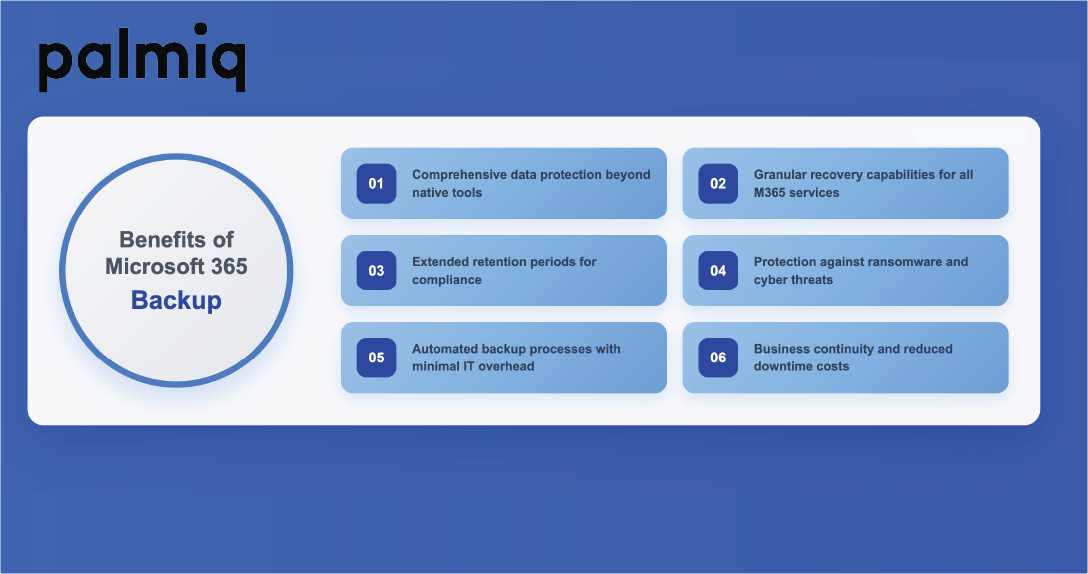In today's digital-first business environment, Microsoft 365 has become the backbone of organizational productivity. With over 400 million users worldwide relying on applications like Outlook, SharePoint, Teams, and OneDrive, businesses have never been more dependent on cloud-based collaboration tools. However, this heavy reliance comes with a critical blind spot that many organizations overlook: the assumption that Microsoft's built-in data protection is sufficient.
The reality is stark. While Microsoft provides excellent uptime and infrastructure reliability, they operate under a shared responsibility model that places the burden of comprehensive data protection squarely on your shoulders. Understanding why Microsoft 365 backup is essential isn't just about compliance or best practices, it's about ensuring business continuity in an increasingly complex digital landscape.
Microsoft's Service Agreement is clear about their responsibilities versus yours. They maintain the infrastructure, ensure service availability, and provide basic retention policies. However, they explicitly state that customers are responsible for protecting their own data. This shared responsibility model creates a dangerous gap that many businesses don't recognize until it's too late.
Microsoft's native retention policies are limited and primarily designed for compliance, not comprehensive data protection. For instance, deleted items in Exchange Online are retained for only 30 days by default, and once that window closes, the data is gone forever. Similarly, SharePoint and OneDrive have limited version history and retention capabilities that may not align with your business needs or regulatory requirements.
Data loss in Microsoft 365 environments happens more frequently than most organizations realize. Accidental deletion represents the most common threat, whether it's an employee mistakenly removing critical files, deleting entire SharePoint sites, or purging important emails. These incidents often go unnoticed until someone needs the missing information, at which point the native retention period may have already expired.
Malicious insider threats pose another significant risk. Disgruntled employees with administrative access can cause devastating damage by intentionally deleting or corrupting data. While access controls help, they can't prevent authorized users from making destructive changes that appear legitimate within the system.Cybersecurity incidents, particularly ransomware attacks, have evolved to specifically target cloud environments. Modern ransomware doesn't just encrypt local files, it systematically works through cloud storage, SharePoint libraries, and OneDrive folders, encrypting or deleting data across your entire Microsoft 365 tenant. Without proper backup, recovering from such attacks becomes exponentially more difficult and expensive.
External attacks through compromised accounts represent another growing concern. When cybercriminals gain access to user credentials, they often work silently within the environment, gradually exfiltrating or corrupting data over extended periods. By the time the breach is discovered, months of data may be compromised, and native retention policies won't help recover the original, uncompromised versions.

Microsoft 365's built-in protection features, while useful, have significant limitations that leave organizations vulnerable. The Recycle Bin functionality provides only short-term recovery options, typically 30-90 days depending on your configuration. Once items are permanently deleted or age out of the recycle bin, they're irretrievable through native means.
Version history in SharePoint and OneDrive offers some protection against file corruption or unwanted changes, but it's limited in scope and duration. The default settings may not preserve enough versions or retain them long enough for comprehensive data protection, especially in collaborative environments where files change frequently.
Litigation Hold and In-Place Hold features are designed for compliance and legal requirements, not operational data protection. They don't provide the granular recovery capabilities needed for day-to-day business operations, and they're not designed to protect against the full spectrum of data loss scenarios organizations face. Perhaps most importantly, Microsoft's native tools don't provide protection against tenant-wide corruption or deletion. If something goes wrong at the organizational level, whether through administrative error, security breach, or system-wide corruption, the native tools may be insufficient to restore operations quickly and completely.
The financial impact of data loss extends far beyond the obvious costs of recreating lost information. When critical business data becomes inaccessible, the ripple effects touch every aspect of operations. Productivity plummets as employees struggle to work without essential files, emails, and collaborative content. Customer relationships suffer when service representatives can't access account histories or project documentation.
Regulatory compliance becomes a nightmare when audit trails are incomplete or missing entirely. Organizations in regulated industries face potential fines, legal liability, and reputational damage that can dwarf the cost of implementing comprehensive backup solutions. The average cost of data loss incidents continues to rise, with some studies suggesting that businesses lose over $10,000 per hour during data unavailability incidents. Recovery time represents another critical factor. While Microsoft's service level agreements guarantee impressive uptime, they don't guarantee data recovery timeframes that align with your business needs. Waiting days or weeks for Microsoft support to attempt data restoration simply isn't viable for most organizations operating in competitive markets.

Implementing a robust Microsoft 365 backup solution provides immediate and long-term benefits that extend throughout your organization. Granular recovery capabilities allow IT teams to restore individual emails, specific file versions, or entire SharePoint sites without disrupting other operations. This precision reduces the scope of disruption and enables faster return to normal operations. Extended retention periods give organizations the flexibility to maintain data for as long as business or regulatory requirements dictate, rather than being constrained by Microsoft's default policies. This extended timeline is particularly valuable for industries with long project cycles or strict compliance requirements.
Cross-platform protection ensures that all Microsoft 365 services, including Exchange, SharePoint, OneDrive, Teams, and Power Platform, receive consistent, comprehensive backup coverage. This unified approach eliminates coverage gaps that could leave critical business data vulnerable. Automated backup processes reduce the administrative burden on IT teams while ensuring consistent protection regardless of human factors. Once configured properly, automated backups run reliably in the background, providing peace of mind without ongoing manual intervention.
Choosing an appropriate backup solution requires careful consideration of your organization's specific needs and constraints. Evaluate solutions based on their ability to provide comprehensive coverage across all Microsoft 365 services your organization uses. The backup solution should integrate seamlessly with your existing IT infrastructure and security policies. Recovery capabilities deserve special attention. Look for solutions that offer multiple recovery options, from individual item restoration to full tenant recovery. The ability to perform cross-tenant migrations or restore to alternative locations can be invaluable during major incidents or organizational changes.
Security features within the backup solution itself are crucial. Your backup data should be encrypted both in transit and at rest, with robust access controls that prevent unauthorized access while enabling legitimate recovery operations. Consider solutions that offer immutable backup storage to protect against ransomware attacks that target backup repositories.
Microsoft 365 backup isn't just another IT checkbox, it's a fundamental business requirement in our interconnected digital economy. The combination of increasing data volumes, evolving security threats, and growing regulatory complexity makes comprehensive backup protection essential for organizational resilience.
The question isn't whether you'll experience data loss, but when and how severe it will be. Organizations that proactively implement robust Microsoft 365 backup solutions position themselves to weather these inevitable challenges with minimal disruption. Those that rely solely on Microsoft's native protection find themselves vulnerable to scenarios that can disrupt operations, damage reputation, and impact long-term viability. Investing in comprehensive Microsoft 365 backup protection today provides the foundation for confident digital collaboration tomorrow. Your business data represents years of accumulated knowledge, relationships, and competitive advantage, protect it accordingly.
